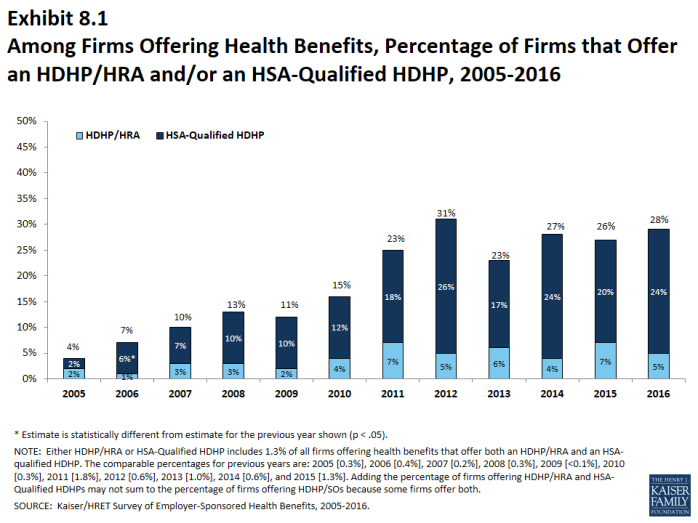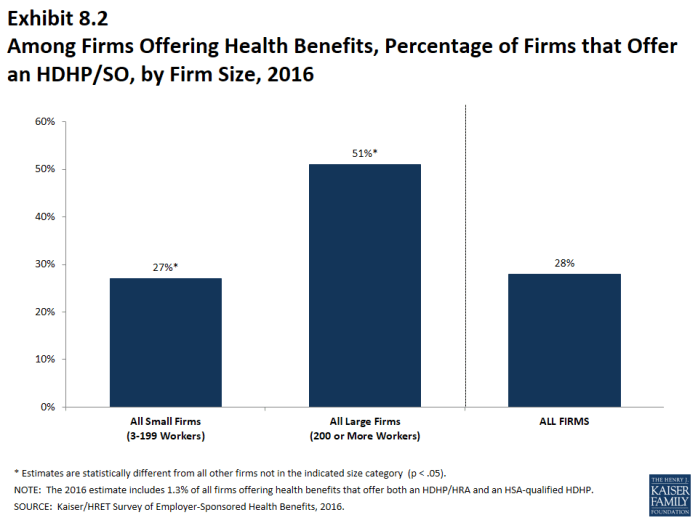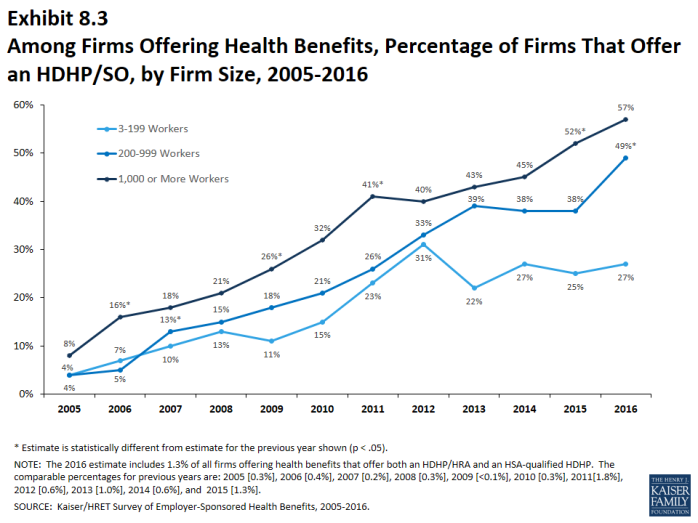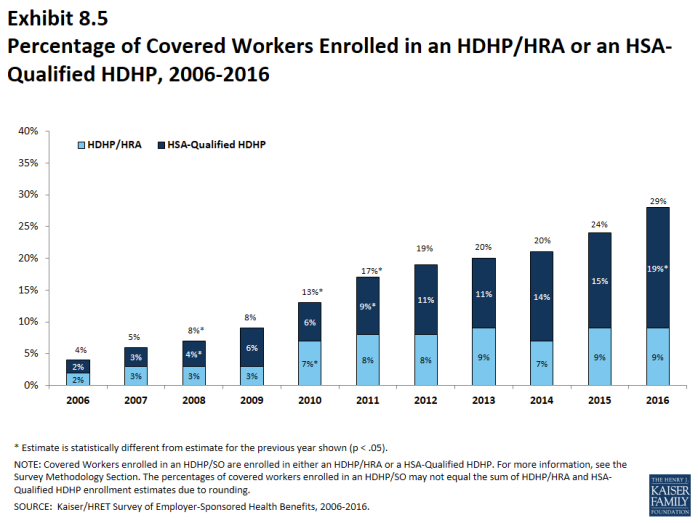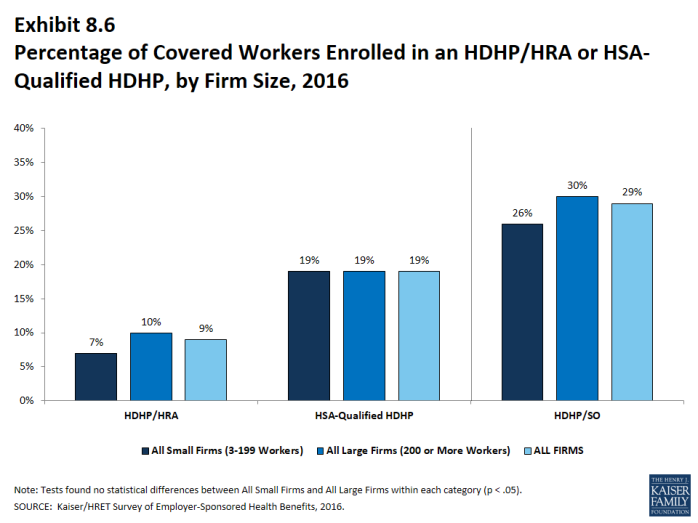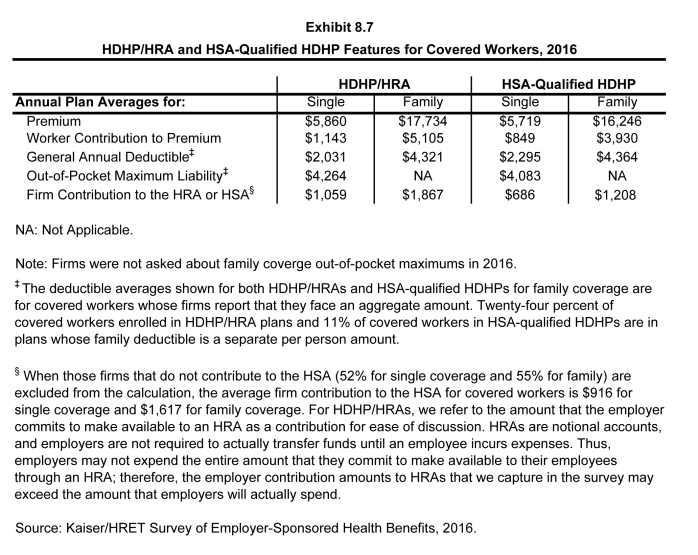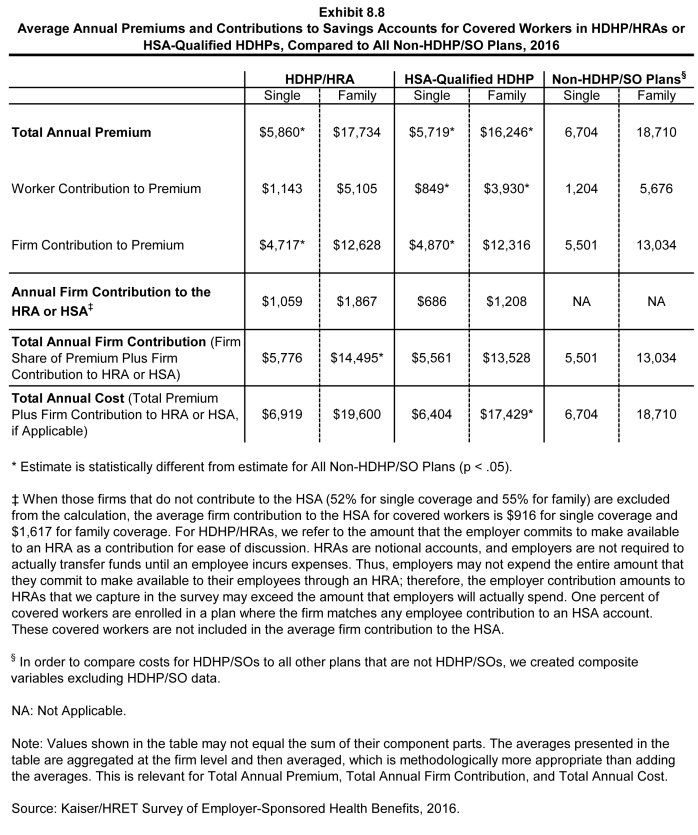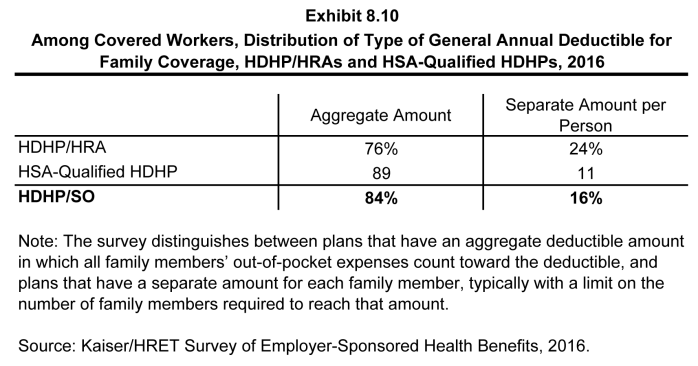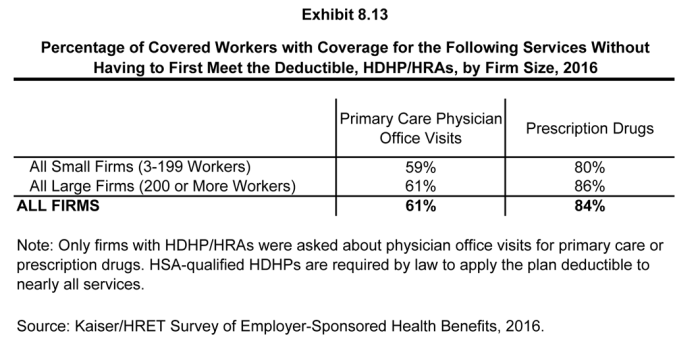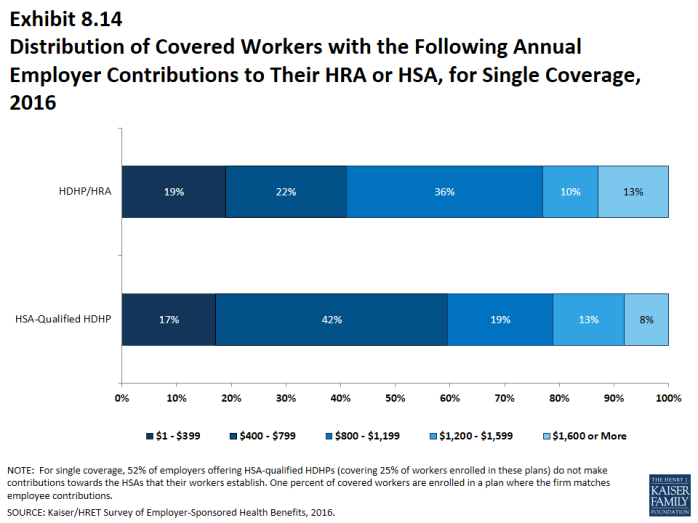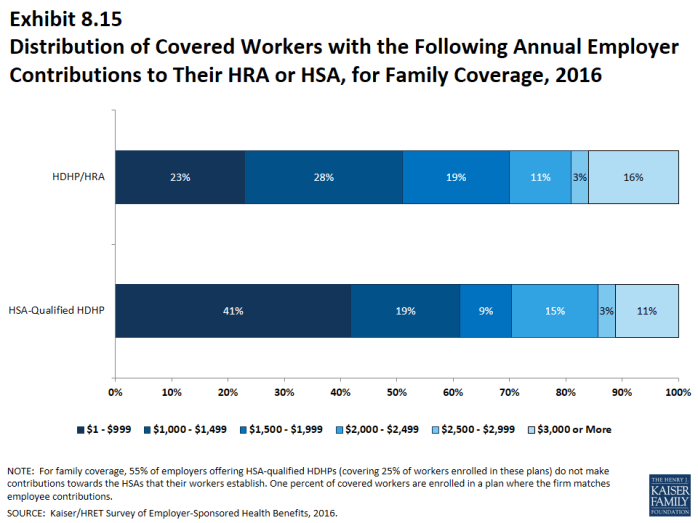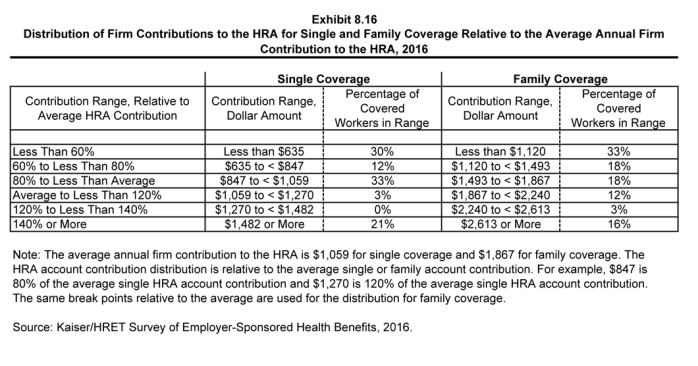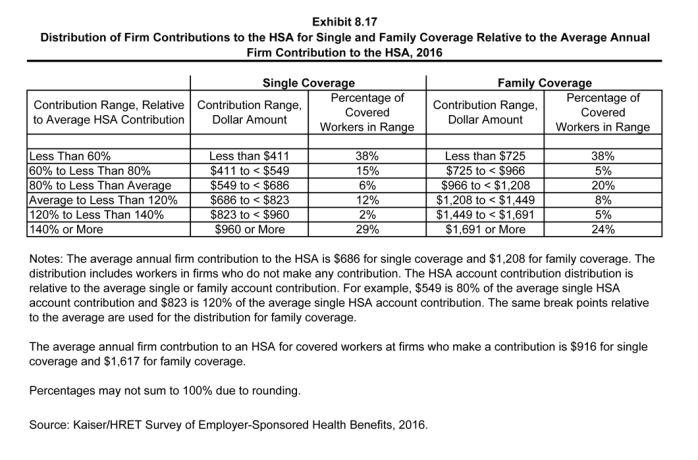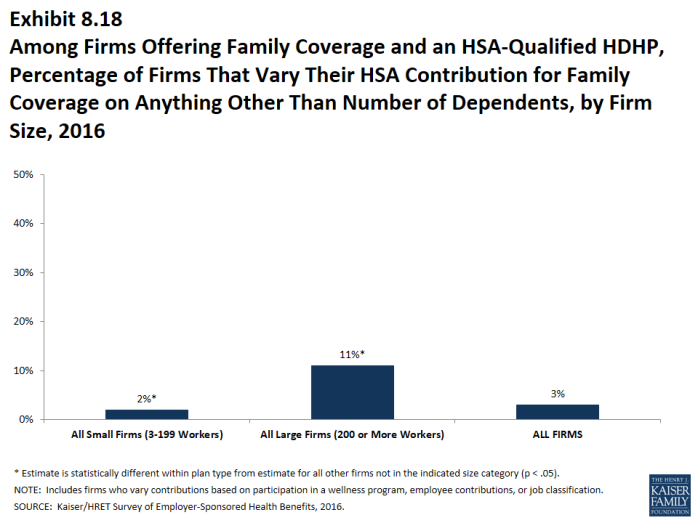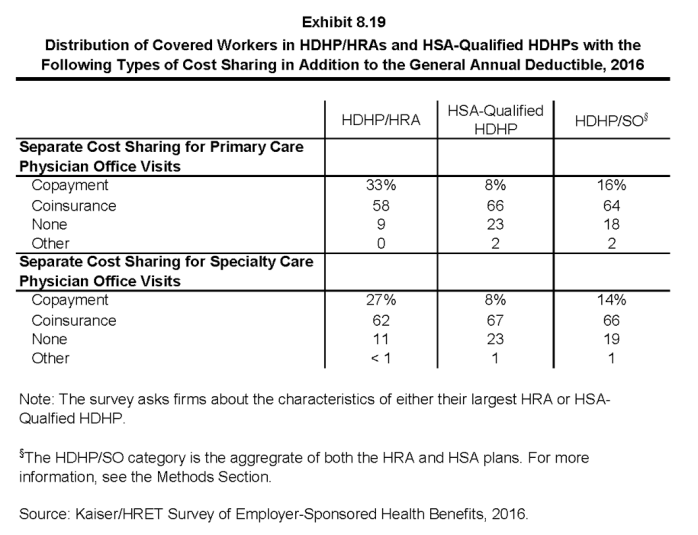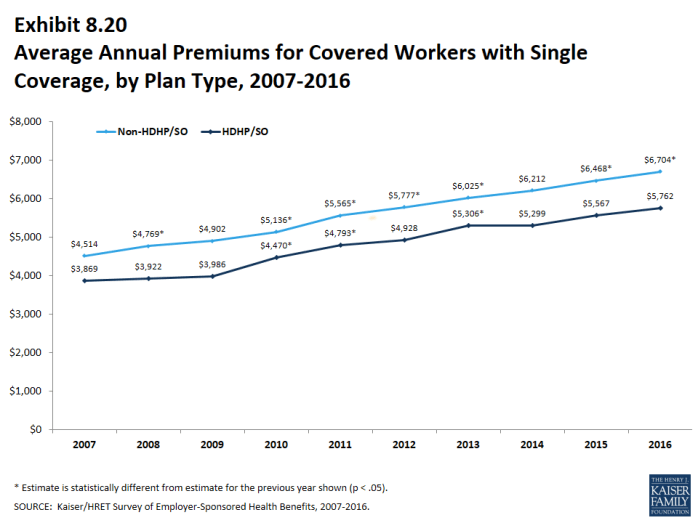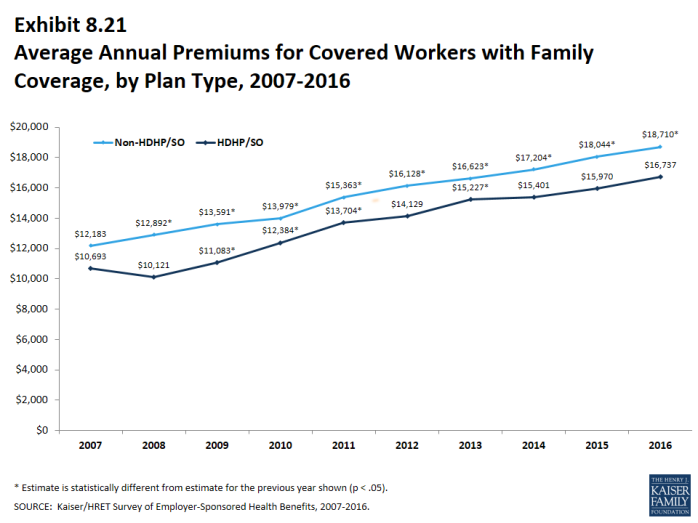2016 Employer Health Benefits Survey
Section Eight: High-Deductible Health Plans with Savings Option
To help cover out-of-pocket expenses not covered by a health plan, some employers offer high deductible plans that are paired with an account that allows enrollees to use tax-preferred savings to pay plan cost sharing and other out-of-pocket medical expenses. The two most common are health reimbursement arrangements (HRAs) and health savings accounts (HSAs). HRAs and HSAs are financial accounts that workers or their family members can use to pay for health care services. These savings arrangements are often (or, in the case of HSAs, always) paired with health plans with high deductibles. The survey treats high-deductible plans paired with a savings option as a distinct plan type – High-Deductible Health Plan with Savings Option (HDHP/SO) – even if the plan would otherwise be considered a PPO, HMO, POS plan, or conventional health plan. Specifically for the survey, HDHP/SOs are defined as (1) health plans with a deductible of at least $1,000 for single coverage and $2,000 for family coverage1 offered with an HRA (referred to as HDHP/HRAs); or (2) high-deductible health plans that meet the federal legal requirements to permit an enrollee to establish and contribute to an HSA (referred to as HSA-qualified HDHPs).2
Percentage of Firms Offering HDHP/HRAs and HSA-Qualified HDHPs, and Enrollment
- Twenty-eight percent of firms offering health benefits offer an HDHP/HRA, an HSA-qualified HDHP, or both. Among firms offering health benefits, 5% offer an HDHP/HRA and 24% offer an HSA-qualified HDHP (Exhibit 8.1). The percentage of firms offering an HDHP/SO is similar to last year but has increased since 2006 (7%).
- Large firms (200 or more workers) are more likely than small firms (3-199 workers) to offer an HDHP/SO (51% vs. 27%). (Exhibit 8.2).
Health Reimbursement Arrangements (HRAs) are medical care reimbursement plans established by employers that can be used by employees to pay for health care. HRAs are funded solely by employers. Employers may commit to make a specified amount of money available in the HRA for premiums and medical expenses incurred by employees or their dependents. HRAs are accounting devices, and employers are not required to expend funds until an employee incurs expenses that would be covered by the HRA. Unspent funds in the HRA usually can be carried over to the next year (sometimes with a limit). Employees cannot take their HRA balances with them if they leave their job, although an employer can choose to make the remaining balance available to former employees to pay for health care.
HRAs often are offered along with a high-deductible health plan (HDHP). In such cases, the employee pays for health care first from his or her HRA and then out-of-pocket until the health plan deductible is met. Sometimes certain preventive services or other services such as prescription drugs are paid for by the plan before the employee meets the deductible.
Health Savings Accounts (HSAs) are savings accounts created by individuals to pay for health care. An individual may establish an HSA if he or she is covered by a “qualified health plan” –a plan with a high deductible (i.e., a deductible of at least $1,300 for single coverage and $2,600 for family coverage in 2016) that also meets other requirements.[1] Employers can encourage their employees to create HSAs by offering an HDHP that meets the federal requirements. Employers in some cases also may assist their employees by identifying HSA options, facilitating applications, or negotiating favorable fees from HSA vendors.
Both employers and employees can contribute to an HSA, up to the statutory cap of $3,350 for single coverage and $6,750 for family coverage in 2016. Employee contributions to the HSA are made on a pre-income tax basis, and some employers arrange for their employees to fund their HSAs through payroll deductions. Employers are not required to contribute to HSAs established by their employees but if they elect to do so, their contributions are not taxable to the employee. Interest and other earnings on amounts in an HSA are not taxable. Withdrawals from the HSA by the account owner to pay for qualified health care expenses are not taxed. The savings account is owned by the individual who creates the account, so employees retain their HSA balances if they leave their job.
1 See U.S. Department of the Treasury, Health Savings Accounts, available at http://www.irs.gov/pub/irs-drop/rp-14-30.pdf
- Enrollment in HDHP/SO plans has increased over time from 17% of covered workers in 2011 to 29% in 2016.
- Nine percent of covered workers are enrolled in HDHP/HRAs in 2016, similar to last year (9%). The percentage of covered workers enrolled in HSA-qualified HDHPs increased from 15% in 2015 to 19% in 2016 (Exhibit 8.5).
- A similar percentage of covered workers at small firms (3-199 workers) and large firms are enrolled in HDHP/SOs (Exhibit 8.5)
Plan Deductibles
- As expected, workers enrolled in HDHP/SOs have higher deductibles than workers enrolled in HMOs, PPOs, or POS plans.
- The average general annual deductible for single coverage is $2,031 for HDHP/HRAs and $2,295 for HSA-qualified HDHPs (Exhibit 8.7). These averages are similar to the amounts reported in recent years. There is wide variation around these averages: 17% of covered workers enrolled in an HDHP/SO are in a plan with a deductible of $1,000 to $1,499 while 21% are in a plan with a deductible of $3,000 or more (Exhibit 8.9).
- The survey asks employers whether the family deductible amount is (1) an aggregate amount (i.e., the out-of-pocket expenses of all family members are counted until the deductible is satisfied), or (2) a per-person amount that applies to each family member (typically with a limit on the number of family members that would be required to meet the deductible amount) (for more information see Section 7).
- The average aggregate deductibles for workers with family coverage are $4,321 for HDHP/HRAs and $4,364 for HSA-qualified HDHPs (Exhibit 8.7). As with single coverage, there is wide variation around these averages for family coverage: 15% of covered workers enrolled in HDHP/SOs with an aggregate family deductible have a deductible of $2,000 to $2,999 while 19% have a deductible of $6,000 dollars or more (Exhibit 8.11).
Out-of-Pocket Maximum Amounts
- HSA-qualified HDHPs are legally required to have a maximum annual out-of-pocket liability of no more than $6,550 for single coverage and $13,100 for family coverage in 2016. Non-grandfathered HDHP/HRA plans starting in 2016 are required to have out-of-pocket maximums of no more than $6,850 for single coverage and $13,700 for family coverage. Virtually all HDHP/HRA plans have an out of pocket maximum for single coverage in 2016.
- The average annual out-of-pocket maximum for single coverage is $4,264 for HDHP/HRAs and $4,083 for HSA-qualified HDHPs (Exhibit 8.7).
Premiums
- The average annual premiums in 2016 for covered workers in HDHP/HRAs are $5,860 for single coverage and $17,734 for family coverage. The average single premium for covered workers in HDHP/HRAs is lower than the average single premium for covered workers in non-HDHP/SO plans (Exhibit 8.8).
- The average annual premium for workers in HSA-qualified HDHPs is $5,719 for single coverage and $16,246 for family coverage. These amounts are significantly less than the average single and family premium for covered workers in plans that are not HDHP/SOs (Exhibit 8.8).
- The average single and family coverage premiums for HSA-qualified HDHPs are similar to the premiums for covered workers enrolled in HDHP/HRAs.
Worker Contributions to Premiums
- The average annual worker contributions to premiums for workers enrolled in HDHP/HRAs are $1,143 for single coverage and $5,105 for family coverage (Exhibit 8.8).
- The average annual worker contributions to premiums for workers in HSA-qualified HDHPs are $849 for single coverage and $3,930 for family coverage. The average contributions for single and family coverage for covered workers in HSA-qualified HDHPs are significantly less than the average premium contribution made by covered workers in plans that are not HDHP/SOs (Exhibit 8.8).
Employer Contributions to Premiums and Savings Options
- Employers contribute to HDHP/SOs in two ways: through their contributions toward the premium for the health plan and through their contributions (if any, in the case of HSAs) to the savings account option (i.e., the HRAs or HSAs themselves).
- Looking at only the annual employer contributions to premiums, covered workers in HDHP/HRAs on average receive employer contributions of $4,717 for single coverage and $12,628 for family coverage. The average employer contribution for covered workers in HDHP/HRAs for single coverage is lower than the average contribution for covered workers in plans that are not HDHP/SOs (Exhibit 8.8).
- The average annual employer contributions to premiums for workers in HSA-qualified HDHPs are $4,870 for single coverage and $12,316 for family coverage. The average employer contribution for covered workers in HSA qualified HDHPs for single coverage is lower than the average contribution for covered workers in plans that are not HDHP/SOs (Exhibit 8.8).
- When looking at employer contributions to the savings option, covered workers enrolled in HDHP/HRAs on average receive an annual employer contribution to their HRA of $1,059 for single coverage and $1,867 for family coverage (Exhibit 8.8).
- HRAs are generally structured in such a way that employers may not actually spend the whole amount that they make available to their employees’ HRAs.3 Amounts committed to an employee’s HRA that are not used by the employee generally roll over and can be used in future years, but any balance may revert back to the employer if the employee leaves his or her job. Thus, the employer contribution amounts to HRAs that we capture in the survey may exceed the amount that employers will actually spend.
- Covered workers enrolled in HSA-qualified HDHPs on average receive an annual employer contribution to their HSA of $686 for single coverage and $1,208 for family coverage (Exhibit 8.8). These amounts do not include the 1% of covered workers in HSA-qualified HDHPs whose employers say they vary account contributions based on certain factors, such as participation in a wellness program or job classification.
- In many cases, employers that sponsor HSA-qualified HDHP/SOs do not make contributions to HSAs established by their employees. Fifty-two percent of employers offering single coverage and 55% offering family coverage through HSA-qualified HDHPs do not make contributions towards the HSAs that their workers establish. Twenty-five percent of workers with single coverage and 25% percent of workers with family coverage in an HSA-qualified HDHP do not receive an account contribution from their employer (see notes in (Exhibit 8.14) and (Exhibit 8.15).
- The average HSA contributions reported above include the portion of covered workers whose employer contribution to the HSA is zero. When those firms that do not contribute to the HSA are excluded from the calculation, the average employer contribution for covered workers is $916 for single coverage and $1,617 for family coverage.
- The percentage of covered workers enrolled in a plan where the employer makes no HSA contribution for single coverage (25%) is similar to the percentage in recent years.
- Employer contributions to savings account options (i.e., the HRAs and HSAs themselves) for their employees can be added to their health plan premium contributions to calculate total employer contributions toward HDHP/SOs.
–
We note that HRAs are a promise by an employer to pay up to a specified amount and that many employees will not receive the full amount of their HRA in a year, so adding the employer premium contribution amount and the HRA contribution represents an upper bound for employer liability that overstates the amount that is actually expended. Since employer contributions to employee HSA accounts immediately transfer the full amount to the employee, adding employer premium and HSA contributions is a good way to look at their total liability under these plans.- For HDHP/HRAs, the average annual total employer contribution for covered workers is $5,776 for single coverage and $14,495 for family coverage. The average total employer contribution amounts for covered workers for family coverage in HDHP/HRAs are higher than the average amount that employers contribute towards family coverage in health plans that are not HDHP/SOs (Exhibit 8.8).
- For HSA-qualified HDHPs, the average total annual firm contribution for covered workers is $5,561 for single coverage and $13,528 for workers with family coverage. The average total firm contribution amounts for single and family coverage in HSA-qualified HDHPs are similar to the average firm contributions towards single and family coverage in health plans that are not HDHP/SOs (Exhibit 8.8).
Variation in Employer Contributions to Savings Options
- There is considerable variation in the amount that employers contribute to savings accounts.
- Looking at how contributions vary around the average, 30% of covered workers in HDHP/HRAs have an HRA contribution for single coverage of less than $635 (60% of the average), while 21% have an account contribution of $1,482 (140% of the average) or more (Exhibit 8.16).
- Thirty-eight percent of covered workers in HSA-qualified HDHPs have an annual HSA contribution for single coverage of less than $411 (60% of the average) while 29% have an account contribution of $960 (140% of the average) or more (Exhibit 8.17).
Cost Sharing for Office Visits, Outpatient Surgery and Hospital Surgery
- The cost-sharing pattern for primary care office visits differs for workers enrolled in HDHP/SOs. Thirty-three percent of covered workers in HDHP/HRAs have a copayment for primary care physician office visits compared to 8% enrolled in an HSA-qualified HDHP (Exhibit 8.19). Workers in other plan types are much more likely to face copayments than coinsurance for physician office visits (see Section 7 for more information).

